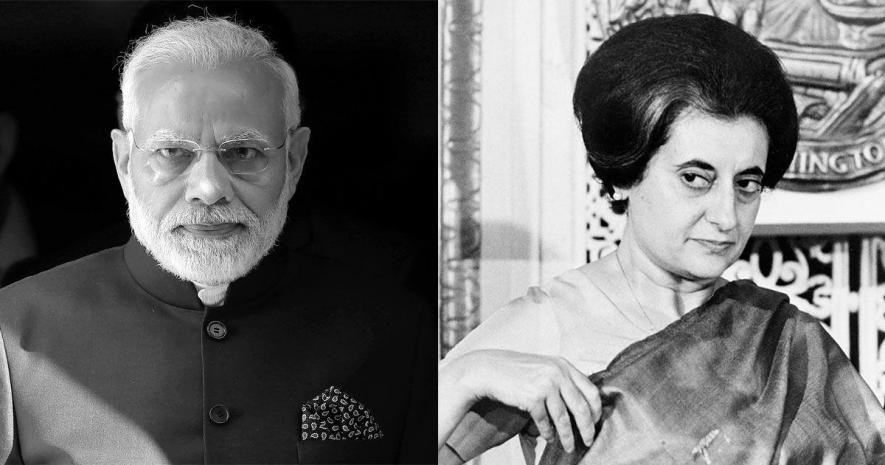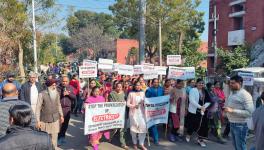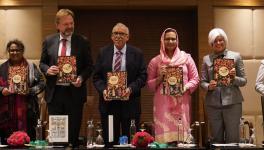Emergencies of the Past and Facades of Freedom in the Present

Image credit: Scroll.in
Whether I look back at the 1975 Emergency or the one today, I do not want the point of view of a victim. Victimhood robs us of our participation in the creation of history. It reduces us to mere objects of history. Instead, I would like to assume the vantage point of people as the makers of history. Yes, the government today wields powers that seemingly overwhelm individuals and organisations. But it is the people, and their actions, that finally determine history—not as we please or when we please, but in ways neither the people nor their rulers anticipate.
Indira Gandhi’s Emergency was eventually laid to rest in the 1977 election in a way even Opposition parties had not anticipated. A hesitant Opposition, unaware of the people’s sentiments about the emergency, was swept into power, just as a shocked Congress was swept out. If the state was the principal actor onstage during Emergency, the people took over the stage in its dismissal.
Do not take people’s silence for assent: This was the crucial lesson of the emergency for our generation. Mrs Gandhi and the Congress party mistook their silencing of the people through the Maintenance of Internal Security Act and Defence of India Rules for consent. The Supreme Court, to its shame, accepted in the ADM Jabalpur verdict—I was a petitioner in the case, which NM Ghatate argued on my behalf in the Supreme Court—that those of us who had been detained under MISA did have the right to life and liberty but could not exercise this right through the justice system. In the chilling words of then-Attorney-General Niren De, if even a constable shoots someone during an emergency, people have no recourse.
Instead of an emergency, the Bharatiya Janata Party has, today, weaponised a bouquet of laws, such as the Unlawful Activities (Prevention) Amendment Act or UAPA and the Prevention of Money Laundering Act or PMLA. Both make bail difficult. These draconian laws, supposedly created with different objectives, have been repurposed to intimidate, harass or silence anybody the current government does not like. The instruments of this repurposed policy are not only the police but the Enforcement Directorate and that old weapon of the state, the Income Tax Department. The press has not been directly muzzled, as during the emergency. But the various instruments of coercion are in full play: news organisations are raided, spurious cases lodged, advertisements cancelled, etc.
New laws are in the offing to address the more recalcitrant digital media. The Ministry of Information and Broadcasting will set up a “fact-checking” section, a version of the Orwellian Ministry of Truth, whose directions will be “final”.
While the weaponisation of the state is similar in many ways to the emergency era, there are also dissimilarities. The courts of law provide a thin line of judicial protection, which was not the case during the earlier Emergency. But the attack on the Constitution continues in various forms. Citizenship laws, anti-conversion laws, the abrogation of Article 370 for Jammu and Kashmir, laws banning cow slaughter, and anti-conversion laws in many states are only some examples of these attacks. Simultaneously, changing the rules of many laws to expand their scope and sneaking in new provisions as money bills have become a routine tactic to expand state power.
While the courts have provided some relief to citizens, they have shied away from contesting the core project of the BJP government—using the existing legal structure, tweaking language here and there, to convert the secular core of the state to a sectarian one that makes Muslims and Christians second-class citizens.
Complementing the weaponisation of the state are the various armed senas and dals formed in the name of “protecting” cows. Many such brigades have close links with local police and are financed by cow protection funds. The mob lynchings, for instance, of Junaid and Nasir from Haryana, Akhlaq in Dadri, Uttar Pradesh, and Pehlu Khan in Alwar, Rajasthan, speak of the complicity of the state with cow vigilantism.
Then there are numerous bhakts whose sentiments are so easily hurt that police have to immediately file FIRs and launch criminal investigations to assuage these sensitive souls. Never mind their vituperative attacks against anybody who dares criticise their great leader or his party on social media, their calls for violence, and their hate speech directed against minorities.
We live in Lewis Carroll’s Looking-glass world, where truth is false, and falsehood is true—Secular views are now sick-ular, and sick-ular views are the “new secular”. In this view, people did not attain independence for India through struggle; Prime Minister Narendra Modi did, during Amrit Kal, by installing the Sengol—suitably anointed by the priests of the Thiruvavaduthurai Adheenam—in the new Parliament building.
Behind the optics of Amrit Kal and anointing Modi as the great leader is the reality of replacing the secular state India aspired to become through its “We the people” declaration in the Constitution. It is the people of India who, through their battle for independence, gave the country the Constitution Dr BR Ambedkar drafted. It embodies the will of “We the People”, their aspirations and desire for development, education, health and equity in a free India—not a country where independence means a transformation from British Raj to Billionaire Raj.
Mrs Gandhi knew she needed the affirmation of the people through a truly free election. The current dispensation believes the facade of freedom combined with control over the media, including social media, is enough. Yes, it may be possible to do this for a short time, in a few states, often by creating warlike conditions between neighbours and constantly appealing to people to close ranks behind the great leader. But not for long, not across the country. As English poet PB Shelly’s immortal lines say: “Ye are many, they are few”.
This article was written for PUCL’s forthcoming special bulletin and web feature, “Past as Present: Remembering the Emergency and Living in an Undeclared Emergency”.
Get the latest reports & analysis with people's perspective on Protests, movements & deep analytical videos, discussions of the current affairs in your Telegram app. Subscribe to NewsClick's Telegram channel & get Real-Time updates on stories, as they get published on our website.
























